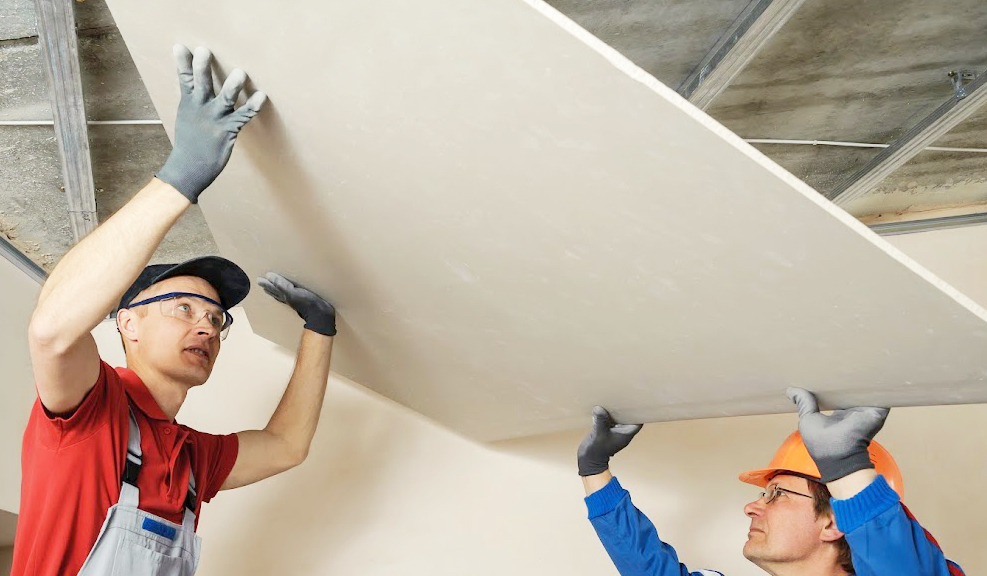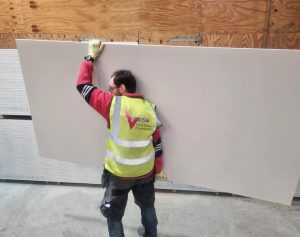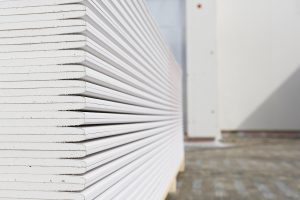What is Ultralight Plasterboard?
Ultralight plasterboard also called lightweight drywall is a lighter alternative to standard plasterboard. The light weight will make carrying and installing plasterboard easier and faster.
Plasterboard is a great product with many advantages but heavy weight is defiantly a disadvantage. Lightweight plasterboard became really popular in the US market because of the easier material handling on site which speeds up the installation process.
But what are ultralight plasterboard advantages and disadvantages and how is it different to standard plasterboard?

Difference between ultralight plasterboard and standard plasterboard?
The main difference is that ultralight plasterboard is ca. 25% lighter than standard plasterboard. Ultralight plasterboard is a generic term across different plasterboard manufactures. A panel of 12.5mm thick ultralight plasterboard weighs ca. 6kg less than standard 12.5mm thick drywall sheets. This does not sound like much but it makes a significant difference. Ultralight plasterboard has been formulated to achieve pretty much the same strength and physical performance as standard boards according to Manufacturer specifications.
All plasterboard including lightweight boards are made from glass fiber, gypsum or calcium sulfate dehydrate. Manufacturers do not disclosing the exact composition of ultralight boards. However a slightly higher degree of pregelatinized corn starch and a special type of surfactant may help account for the lightweight and the strength of the board.
Advantages and disadvantages of ultralight Plasterboard:
- Easier to carry
- Cheaper to transport
- Easy and faster to install
- Less dusty when cutting
- Health & Safety advantages. Reduction of workplace injuries by lifting lighter material.
- Less susceptible to sagging on ceilings
Disadvantages of ultralight plasterboard:
- Slight reduction in soundproofing
- Only comes as standard board. No ultralight fire or moister resistant boards
- Has a consistency that takes some getting used to if you’re experienced with standard plasterboard

Installation, Maintenance and Repair of ultralight plasterboard
The installation of ultralight drywall is the same as standard drywall products. However ultralight plasterboard is easier to install due to its weight and therefore faster. Both products have pretty much the same profile for maintenance and repair. Some users report that one product is somewhat more susceptible to cracking under impact over the other product however current tests show they are pretty much the same. Any damage is generally easily repaired with a little additional taping and mudding work.
Should I use Ultralight Plasterboard?
Ultralight plastered is mainly marketed to professional dryliners and large contractors. For someone who carries the product every day or to contractors who need to think about issues such as workplace injuries and productivity. Adopting ultralight plasterboard may have a significant positive impact on health & safety for workers. The higher speed of installation will positively effect the bottom line of a contractor at the end of the year.
For Do-It-Yourself homeowners the lightweight boards will defiantly be easier to handle and install. Heavy plasterboard can result in aches and pains for even the strongest person. Plasterboard is always heavy and bulky to carry and there is no way around that. But this significantly lighter board may help DIY with the difficult loading and unloading tasks and especially when it is necessary to hold the sheets overhead for ceiling installations.
The advantages of Ultralight plasterboard outweigh the disadvantages but some drylines will always use standard weight boards because “that’s how I’ve always done it.”
Conclusion
Plasterboard is these days a standard construction material pretty much used to construct most interior walls and ceiling surfaces. It’s a great product with many advantages but the main disadvantages is the large size and heavy weight. With ultralight plasterboards at we are reducing some of the disadvantages and speed up productive and health & safety along the way.
Facts you should know about Plasterboard
What is plasterboard?
Plasterboard is made of gypsum sandwiched between two sheets of lining paper. It is also referred to as drywall, wallboards, gypsum boards, sheet rock and gypsum panel

What is drywall used for?
It is mainly used for the construction of interior walls and ceilings.
What types of gypsum boards are there?
Gypsum boards help meet building regulations. For example fire safety regulations. There are many different types of boards. For instance the most popular types are:
Standard plasterboard:
This is by far the most popular board type because it is suitable for most application. Therefor standard boards are use for walls and ceilings with normal fire, acoustic and moisture levels.
Fireproof or Fire Rated Plasterboard:
A special glass fibre reinforced gypsum board which usually comes with a pink paper face. Depending on the thickness of the board and the construction of the stud wall, fire resistance of 30, 60, 90 and even a 120 minutes can be achieved.
Acoustic Plasterboard:
The density of this board is higher than that of standard drywall boards. As a result it will reduce noise transmission such as speech and music to improve insulation against sound. It is most often used with additional mineral wool and resilient bars to reduce sound vibration.
Moisture resistance plasterboard:
Used for bathroom, kitchens and other areas with high humidity to prevent damp penetrating the board.
Impact resistant Plasterboard:
This board has a very dense core and is lined with heavy duty paper to resit damage caused by impact or vibrations.
What Sizes of Plasterboard are available?
The standard width of gypsum board is 1200 mm wide. This is to fit the standard 600mm centres of studs for walls or 400mm centres for furrings in ceilings. Standard length is 2400mm to fit a standard room height however wallboards are available in many different sizes and thickness with the most popular being:
- 2400mm x 1200mm
- 2700mm x 1200mm
- 3000mm x 1200mm
Boards usually come in a standard thickness of 12.5mm but are also available in other sizes such as 6mm or 15mm.
What Plasterboard brands are out there?
In the UK the major drywall manufactures are British Gypsum, Knauf and Siniat.
The difference between Tapered edged and square edged boards?
Most boards comes with the option of tapered edge (TE plasterboard) or square edged (SE plasterboard). Tapered edge boards are for tape and joint whilst square edge board are best suited for skimmed finishes. Some specialist boards are available with square edges only.
Plasterboard which side?
Most standard gypsum boards have a grey side and a brown side. The grey side should face out as it is specially designed for plastering (skimming). Paper liners are usually made from recycled paper which is great news for the environment.
